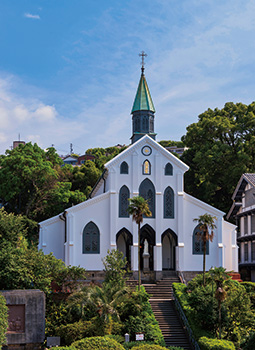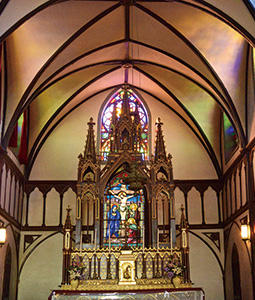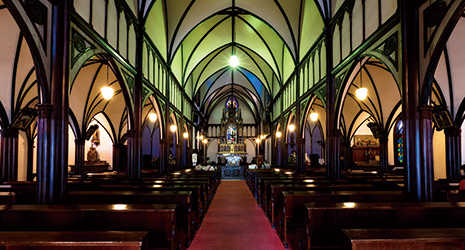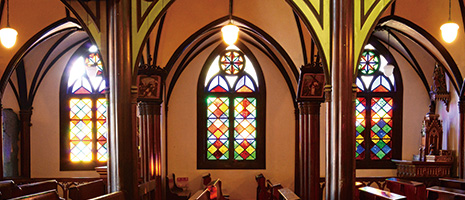INDEX

Oura Cathedral stands on a hill in Nagasaki City, Nagasaki Prefecture 
Oura Cathedral altar
- PREVIOUS
- NEXT
November 2020
The Church on the Hill in Nagasaki

Standing on a hill overlooking Nagasaki Bay is Oura Cathedral, one of the most important examples of Christian church architecture in Japan.

In the Edo period (1603–1867), exchange and trade with foreign countries was highly restricted by the Tokugawa shogunate. However, in 1858, the shogunate signed treaties of amity and commerce with the United States, the Netherlands, Russia, Great Britain and France, and the following year, Hakodate, Yokohama and Nagasaki were designated as trade ports. In each of these ports, foreign settlements were established, where foreigners were allowed to build their own trading houses and residences.
The Oura district in Nagasaki City, Nagasaki Prefecture, was one such foreign settlement. At the time, many Western-style consulates and houses stood on the hillside with stunning views across Nagasaki Bay. Oura Cathedral, built in 1864 for the benefit of the foreigners living in the settlement, still stands there today. It is the oldest surviving Catholic church in Japan and the only church building to be designated a National Treasure.
The strikingly beautiful exterior of white stucco brick encasing the original wooden structure owes to extension work completed in 1879, but the interior of the building has remained largely unchanged since it was first constructed. The church was designed by the French Roman Catholic priests Louis-Theodore Furet and Father Bernard Thaddée Petitjean, who were posted to Nagasaki at the time. It was built by Koyama Hidenoshin, a master carpenter from Amakusa. Designed in the Gothic style*, Oura Cathedral has a tall octagonal spire with stained glass lancet arched windows to let light into the interior. The high vaulted ceilings typical of Gothic places of worship were constructed using wooden reinforcements known as “rib vaults,” commonly known as “bat-shaped ceilings,” rather than stone as is common in Europe and the United States, testifying to the skill and ingenuity of Japanese carpenters of the time.

Taguchi Koji, facility manager of the Oura Cathedral Preservation Committee, says, “The ceiling is made of bamboo, woven in a distinctive way, and clay. It’s difficult to recreate work such as this with today’s technology.” The roof of Oura Cathedral is made of sangawara** pantiles, which were invented and widely used in the early Edo period.
Christianity was introduced into Japan in 1549 and briefly spread throughout the country until it was banned during the Edo period. Although Oura Cathedral was built as a church for foreigners, a plaque bearing the name of the cathedral in Japanese (Tenshudo) was displayed high on the facade of the building to signal its presence to Japanese people. This was said to be in part due to the priest’s belief that some Japanese people may have been keeping their Christian faith in secret for over 250 years. Sure enough, in 1865, a dozen or so Japanese visited Oura Cathedral and confessed to their faith to Father Petitjean, saying, “We are of one heart with you.” This event was reported to the Vatican and came to be known throughout the world as the “Discovery of the Christians.” After the ban on Christianity was lifted in 1873, believers who had gone into hiding across Nagasaki began to emerge one after another. This historical background contributed to the registration of Oura Cathedral as a UNESCO World Heritage Site in 2018. The church is a core site of the “Hidden Christian Sites in the Nagasaki Region***.”

In World War II, an atomic bomb was dropped on Nagasaki. Oura Cathedral, located a short distance from the epicenter, sustained extensive damage to its main gate, roof, ceiling and stained glass windows. The restoration took five years and was completed in 1952. The cathedral’s original bell survived the War and was housed in a newly built bell tower. This bell still rings twice a day, at noon and in the evening, accompanied by a prayer for peace.
* A style of architecture and art that began in France in the first half of the twelfth century, and was widely influential across the whole of Europe until the sixteenth century. The lancet arches and stained glass of the cathedral are characteristic of this architecture.
** Square tiles with an undulating cross-section
*** The cathedral was designated a UNESCO World Heritage Site in 2018 for its role in the survival of a community of believers who, for 250 years of severe oppression under the Ban on Christianity during the Edo period, preserved their faith without the presence of missionaries, while remaining connected to mainstream society.
- PREVIOUS
- NEXT

